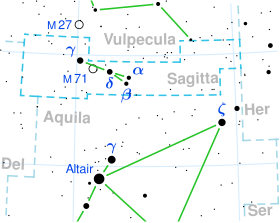astro.wikisort.org - Star
V Sagittae or V Sge is a cataclysmic variable binary star system in the constellation Sagitta that is expected to go nova and briefly become the most luminous point of light in the Milky Way and one of the brightest stars in our sky around the year 2083.[5][6] The system is composed of a main sequence star of about 3.3 solar masses and a white dwarf of about 0.9 solar masses; the fact that the white dwarf is less massive than its companion is highly unusual,[5] and V Sge is the only super soft X-ray source nonmagnetic cataclysmic variable found so far.
![A visual band light curve for V Sagittae, adapted from Šimon and Mattei (1999)[7]](http://upload.wikimedia.org/wikipedia/commons/thumb/4/4b/VSgeLightCurve.png/220px-VSgeLightCurve.png)
 | |
| Observation data Epoch J2000 Equinox J2000 | |
|---|---|
| Constellation | Sagitta |
| Right ascension | 20h 20m 14.691s[1] |
| Declination | +21° 06′ 10.44″[1] |
| Apparent magnitude (V) | 8.6-13.9[2] |
| Characteristics | |
| Variable type | eclipsing and cataclysmic[2] |
| Astrometry | |
| Proper motion (μ) | RA: −2.052[1] mas/yr Dec.: −6.485[1] mas/yr |
| Parallax (π) | 0.4190 ± 0.0320 mas[1] |
| Distance | 7,800 ± 600 ly (2,400 ± 200 pc) |
| Absolute magnitude (MV) | −2.2[3] |
| Orbit[4] | |
| Semi-major axis (a) | 4.36 R☉ |
| Inclination (i) | 71° |
| Semi-amplitude (K1) (primary) | 320 km/s |
| Semi-amplitude (K2) (secondary) | 85 km/s |
| Details | |
| Mass | 0.9[4] M☉ |
| Radius | 1.2[4] R☉ |
| Luminosity | 30,000[4] L☉ |
| Temperature | 70,000[4] K |
| Mass | 3.3[4] M☉ |
| Radius | 2.1[4] R☉ |
| Temperature | 12,000[4] K |
| Other designations | |
AAVSO 1015+20, V Sge, GSC 01643-01764 | |
| Database references | |
| SIMBAD | data |
V Sge has brightened by a factor of 10 over the last century, and based on research reported in 2020, it is expected to continue to brighten and briefly become the brightest star in the night sky sometime around 2083, plus or minus about 11 years.[8] Over the final few months and days the pair will coalesce and go nova, eventually becoming a red giant star.
The stars orbit each other about every 0.514 days, and eclipse each other each orbit. The pair is viewed in the late stages of their spiral in. Their orbital period currently decreases by 4.73 * 10−10 days per cycle, a rate which will accelerate.
Material from the larger star is accreting onto the white dwarf at an exponentially increasing rate, generating a huge stellar wind. The doubling time for the accretion rate, and hence for the system luminosity, is about 89 years.[3]
References
- Brown, A. G. A.; et al. (Gaia collaboration) (August 2018). "Gaia Data Release 2: Summary of the contents and survey properties". Astronomy & Astrophysics. 616. A1. arXiv:1804.09365. Bibcode:2018A&A...616A...1G. doi:10.1051/0004-6361/201833051. Gaia DR2 record for this source at VizieR.
- Samus, N. N.; Durlevich, O. V.; et al. (2009). "VizieR Online Data Catalog: General Catalogue of Variable Stars (Samus+ 2007-2013)". VizieR On-line Data Catalog: B/GCVS. Originally Published in: 2009yCat....102025S. 1: B/gcvs. Bibcode:2009yCat....102025S.
- "V Sagittae technical details:" (PDF). Retrieved 2021-10-03.
- Smak, Jozef I.; Belczynski, K.; Zola, S. (2001). "V Sge: A Hot, Peculiar Binary System". Acta Astronomica. 51: 117. Bibcode:2001AcA....51..117S.
- "Binary star V Sagittae to explode as very bright nova by century's end". phys.org. Retrieved 2020-01-09.
- "CNN - Breaking News, Latest News and Videos". m.cnn.com. Retrieved 2020-01-09.
- Šimon, V.; Mattei, J. A. (October 1999). "The peculiar binary V Sagittae: Properties of its long-term light changes". Astronomy and Astrophysics Supplement Series. 139: 75–88. doi:10.1051/aas:1999381. Retrieved 3 March 2022.
- "235th AAS Session Meeting Abstracts Table of Contents" (PDF). AAS. 2020-01-02.
{{cite web}}: CS1 maint: url-status (link)
На других языках
- [en] V Sagittae
[ru] V Стрелы
V Стрелы (лат. V Sagittae) — катаклизмическая переменная двойная звезда в созвездии Стрелы. Вероятно, звезда скоро вспыхнет как новая и станет одной из самых ярких звёзд в Млечном Пути и на небе Земли[5][6]. Двойная система состоит из звезды главной последовательности массой 3 массы Солнца и белого карлика с массой 0,9 масс Солнца. Тот факт, что белый карлик меньше, чем звезда-компаньон, весьма необычен. V Стрелы является единственным источником сверхмягкого рентгеновского излучения среди обнаруженных немагнитных катаклизмических переменных звёзд.Другой контент может иметь иную лицензию. Перед использованием материалов сайта WikiSort.org внимательно изучите правила лицензирования конкретных элементов наполнения сайта.
WikiSort.org - проект по пересортировке и дополнению контента Википедии